Contents
The grand Greco-Roman ruins of Jerash are one of Jordan’s major tourist attractions, though the site tends to get overshadowed by Petra to the south.
This is one of the best places to visit in the eastern Mediterranean if you want to attempt to imagine what life was like in the Roman era, as Jerash’s incredible state of preservation really allows you a peek behind the curtain to understand how a Roman city functioned.
There has been a settlement here since at least the Chalcolithic era, but Jerash as a town (Ancient Gerasa) was founded during the Hellenistic period.
The city’s heyday began when the Romans took control of the wider region in 64 BC, and Jerash became part of the Roman Decapolis. This loose confederation of provincial towns – spread throughout modern-day Jordan, Israel, and the Palestinian Territories and Syria – sat on the main trade routes and so gained commercial prominence in the region.
Nearly all the grand monuments on display throughout the site today date from the Roman period, particularly from between the 1st and 2nd century, when Jerash, now a prosperous center of trade, showcased its status with additions of colonnaded streets, grand plazas, theaters, and temples.
Jerash’s prosperity continued into the Byzantine era, and several churches have been excavated here. The town’s importance only faded in the 8th century after an earthquake left much of it in ruins.
Jerash is within easy day-tripping distance from Amman, making it one of the top things to do while staying in the capital.
To help you plan your Jerash trip, use our list of the top ruins and temples.
1. Hadrian’s Arch
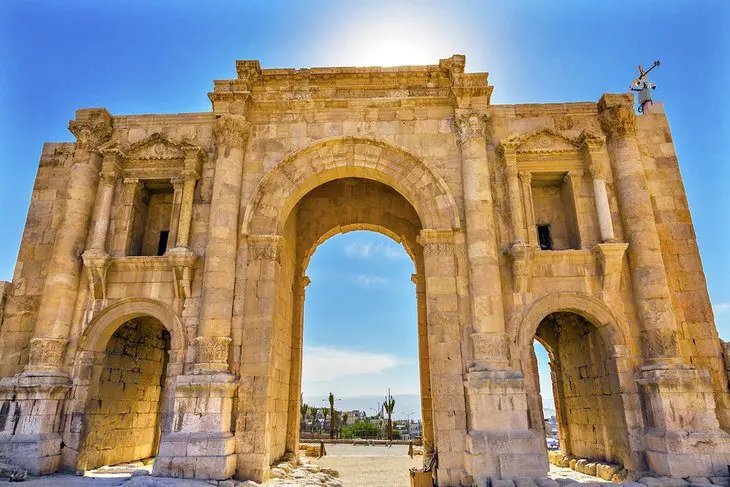
You enter the site of Jerash through this monumental gateway that was constructed to commemorate Emperor Hadrian’s visit in AD 129.
As you pass under the arch, make sure to note the internal decorative carving work. A walkway runs from Hadrian’s Arch for 500 meters to the South Gate where the central set of ruins begin.
Running along the northern side of the walkway is the Jerash Hippodrome, which would have sat 15,000 spectators. Archaeologists have restored and reconstructed much of the Hippodrome, including a section of the tiered seating, allowing visitors to get a feel for how it would have looked originally.
2. Sanctuary of Zeus

Once you’ve passed through the South Gate – a smaller version of Hadrian’s Arch – the first set of major ruins is the Sanctuary of Zeus.
The current temple ruins date from between AD 162-166, but archaeological excavations here have revealed various other earlier temple remains, including one from the Hellenistic era and an earlier temple dating back to an even earlier settlement period.
Most archaeologists believe that during the Hellenistic era, the town was focused around this temple area.
The temple site is a mass of masonry rubble, which is difficult to decipher, but if you climb to the top of the staircase, to what would have been the temenos (the sanctuary where the God Zeus would have lived), you are rewarded with extensive views looking down on the Oval Plaza below.
3. Oval Plaza
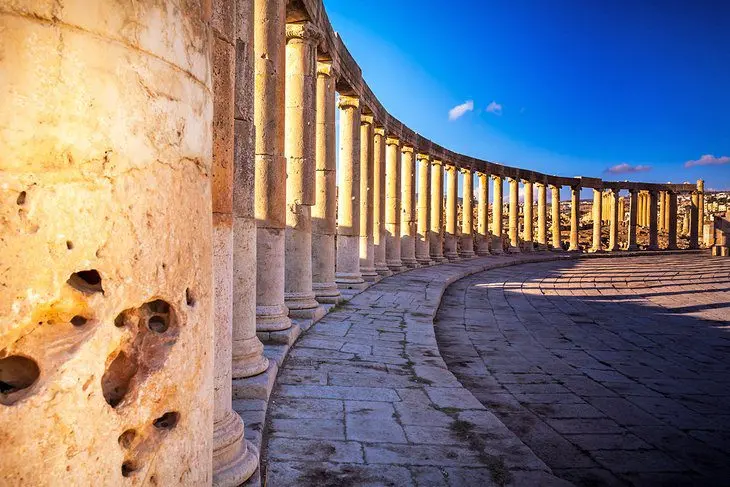
The Oval Plaza is one of Jerash’s most celebrated features.
It is the only oval-shaped plaza ever found in a Classical-era city site and is incredibly well-preserved. The original paving is still underfoot, and its full package of original Ionic columns have been re-erected, so you are seeing the plaza much as Jerash’s Roman-era residents would have.
At the Oval Plaza’s northeast end is the beginning of the Cardo Maximus, but before you follow that road into the heart of the city ruins, take the trail up the hill to the South Theater from where you can get panoramic vistas of the Oval Plaza from above.
4. South Theater

Jerash has two theater complexes, but the South Theater is, by far, the most impressive.
Cut half into the hillside, with seating for 3,000 spectators, the South Theater was built at the end of the 1st century.
Due to extensive reconstruction work, as a whole it is a very striking sight, but visitors should note the well-preserved smaller details on display here, too.
In the seating tiers, look out for Greek letters marking some of the stone slab seats, remnants of the original seat numbering system. Down in the stage area, the backdrop (known as the scaenae frons) has been re-erected, and the masonry is carved with elaborate decoration.
The acoustics from the stage and orchestra areas are exceptional, and you’ll see plenty of fellow visitors testing them out. The best way to experience them, though, is to wait for Jerash’s bagpiper band to troop out into the orchestra area to play a few tunes to demonstrate the acoustics.
This happens regularly throughout the day, whenever enough tourists are in or around the theater area.
Jordan’s bagpiper tradition dates from the British Mandate period (from the end of World War I to independence in 1946), so the choice of instrument isn’t as random as you may first think.
5. Cardo Maximus
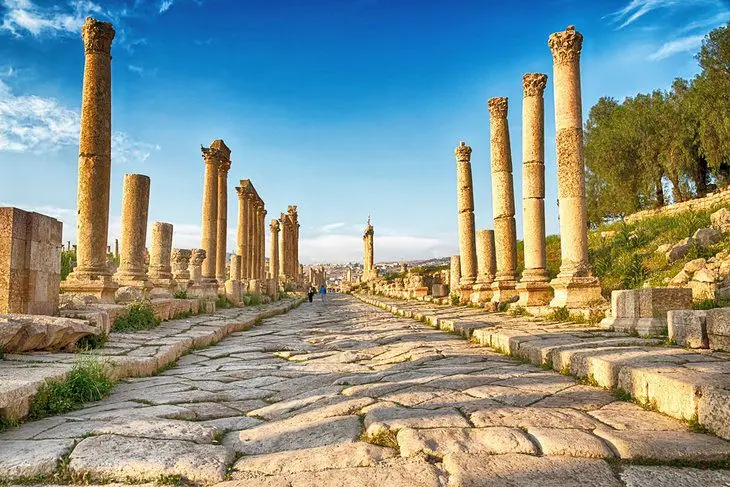
The Cardo Maximus is Jerash’s main road, running northeast from the Oval Plaza to the city’s North Gate.
The paving you are walking upon is original, laid out in the 1st Century, when the Romans decided to begin lavishing money on this prosperous trading town and rolled out a city plan of building works, including this grand main thoroughfare.
Keep your eyes peeled to spot the ruts of chariot wheels scored into the stone slabs at various stages along the road.
At various sections, along the road’s length, the original Ionic columns that rim the road have been re-erected.
Along the road section that runs between the Oval Plaza and the South Tetrapylon, you can see the remains of Jerash’s Agora (marketplace). This was discovered by archaeologists in the 1970s, putting to bed the earlier theory that the Oval Plaza had served this role in the city.
A little farther on is the South Tetrapylon, which marks the Cardo’s intersection with the South Decumanus road.
You can follow the South Decumanus up to the remains of an Umayyad-era house before returning and continuing along the Cardo.
6. Cathedral Complex

The first major monument after the South Tetrapylon, along the Cardo Maximus, is the Cathedral Complex, which was built during Jerash’s Byzantine period.
By the early 4th century, Jerash had a significant Christian population, and by the mid-century, the town had become a bishopric. Like many of the churches excavated in Jerash, this site was built atop an earlier Classical-era temple.
From the Cardo, stairs lead up to a courtyard space, known as the Fountain Court, from where you can access the cathedral’s remaining basilica ruins, as well as the separate Church of St. Theodore.
The Church of St. Theodore is the better preserved church building of the two, and you can easily see the layout of the building with its side aisles and central nave.
7. Three Church Ruins
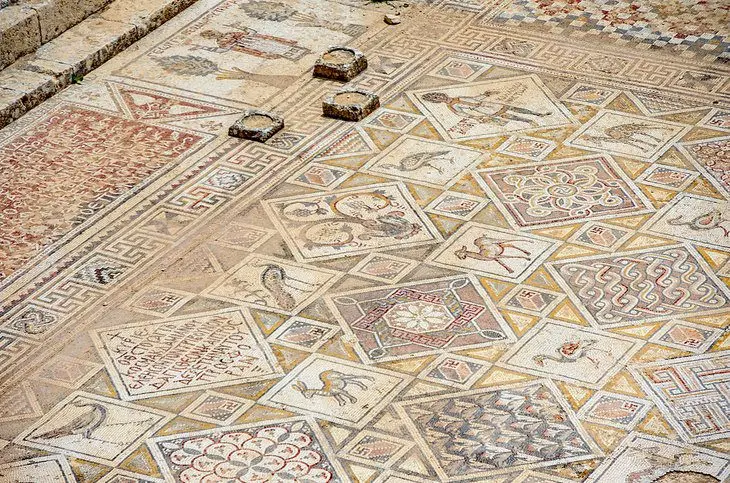
From the Cathedral Complex, it is well worth diverting off the main Cardo Maximus route and taking the rough trail up the hill to view three further church ruins.
The Church of St. George, Church of St. John the Baptist, and Church of SS Cosmas & Damian were all built between AD 529 and 533, and sit in a row sharing an entrance atrium.
The Church of SS Cosmas & Damian is the most interesting, as it contains a vibrant and intricately decorated mosaic floor, which is the best preserved example of mosaic art excavated in Jerash.
The mosaic is viewed from above (to prevent the floor being damaged, the church is not open) which allows you an excellent perspective of the floor’s artistry.
The Greek inscription beside the church’s altar, dates the mosaic floor to AD 533. The mosaic illustrations depict various animals and portraits, contained in a pattern of diamonds and squares.
Beside the Church of SS Cosmas & Damian, you can enter both the Church of St. George and the Church of St. John the Baptist. Each contain scraps of mosaic decoration.
8. Nymphaeum
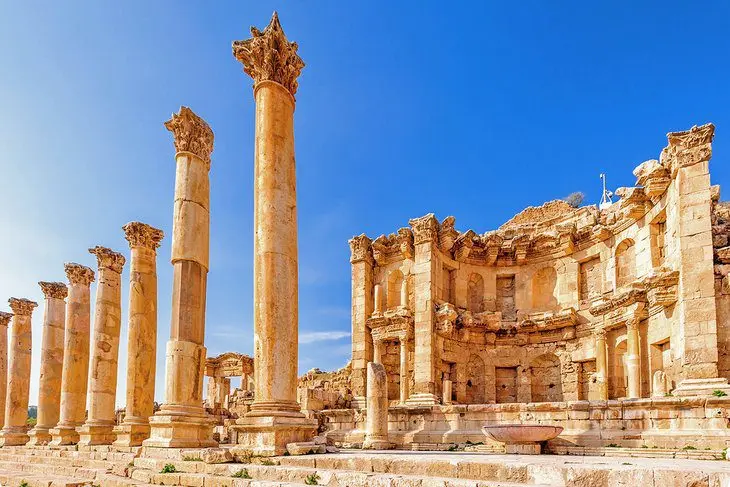
Jerash’s Nymphaeum is just to the north of the Cathedral Complex, along the Cardo Maximus.
A nymphaeum is a public fountain, found in most Roman city ruins, and Jerash’s one dates from the 2nd century.
It is by far the best-preserved nymphaeum monument in any Classical-era site in Jordan.
Here, you can imagine how impressive the area would have been originally, when it was a working public fountain, as the entire two-level back wall of the nymphaeum, with its decorative niches, is still standing.
Originally a domed ceiling would have jutted out from the wall, covering the large basin area below.
9. Sanctuary of Artemis
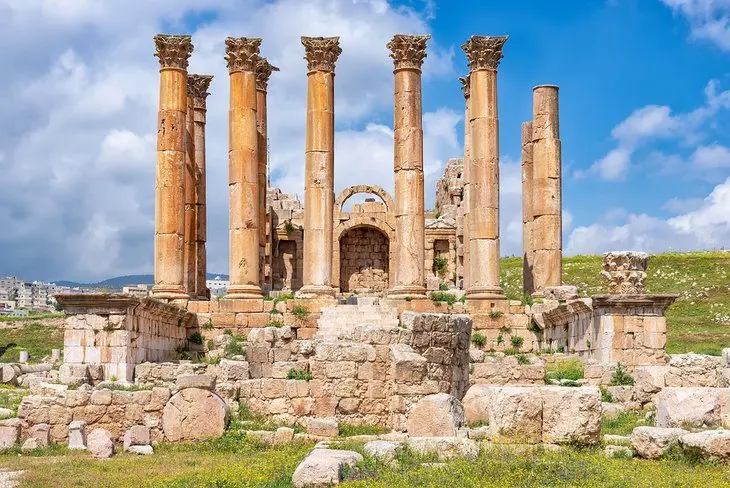
The Sanctuary of Artemis was Jerash’s most important, and largest, temple complex. It dates from Jerash’s heyday era in the mid to late 2nd century.
You can enter the temple complex’s cella (inner temple) using a trail that runs from the Three Churches, but it is much more dramatic and impressive to enter from the monumental staircase beginning at the lowest level along the Cardo Maximus.
Originally, the beginning of the temple entrance would have stretched east of the Cardo Maximus, and if you veer off the road here, you can stand amid the rubble of what was once the propylaeum plaza, which formed part of the temple’s grand entrance.
Cross back onto the Cardo Maximus and begin your ascent up the stairs which, halfway up, leads to an altar terrace. From the altar terrace, the stairway widens into a monumental staircase of three flights, making for a triumphant entranceway.
At the top of the stairs, you can finally see the temple platform with its temenos (the holy of holies where the temple’s god is said to reside) in full. One last flight of stairs leads up to the platform.
The platform is rimmed by 10 towering Corinthian columns. The middle column on the southern side is famous, as it sways slightly.
From the temple platform, you can take the rough trail down the hill to the North Theater or backtrack down the monumental staircase to the Cardo Maximus and continue north from there.
10. North Tetrapylon

The North Tetrapylon marks the intersection of the streets of the Cardo Maximus with the North Decumanus.
It is in a much better state of preservation than the South Tetrapylon and is a good example of these Roman decorative junction markers.
If you have time, just before you hit the North Tetrapylon veer off the Cardo into the ruins of the West Baths.
Although the remnants here are mostly a jumble of masonry, and difficult to decipher, it’s well worth a visit due to the sheer scale of the complex. The bath house here was massive, measuring 75 meters by 50 meters.
From the North Tetrapylon, the Cardo Maximus continues for another 200 meters to the North Gate.
11. North Theater
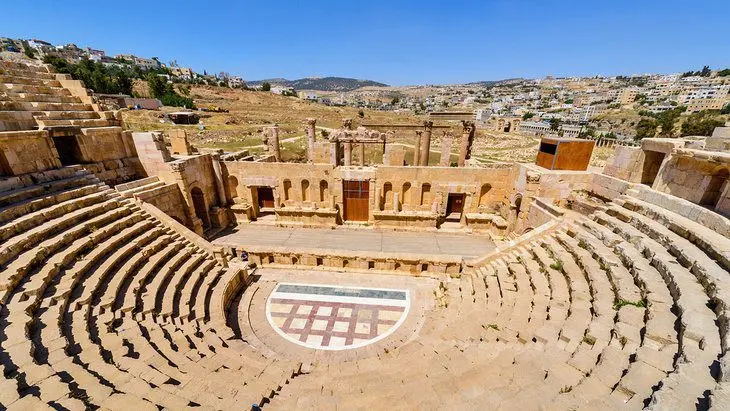
From the North Tetrapylon, head west onto the North Decumanus road to reach Jerash’s North Theater.
This area has been painstakingly reconstructed, with a small columned plaza leading into the theater itself.
The theater is smaller than the South Theater, and excavations here revealed that the original building, dating from around AD 165, was even smaller still. It was then extended in the 3rd century to sit around 1,500 spectators.
The orchestra area has a colorful marble pavement, though this was completed as part of the reconstruction work in the 1990s.
There are great views over the modern town of Jerash from the top seating tier.
From the North Theater, you can continue west to the 6th-century Church of Bishop Isaiah.










